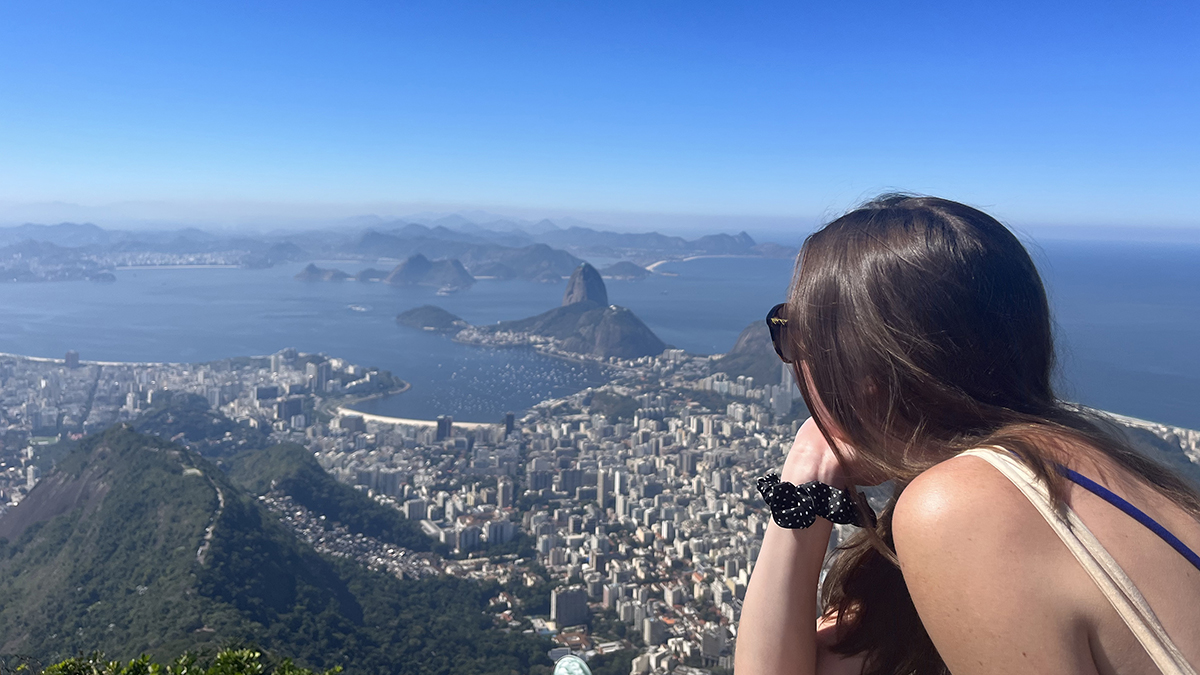Introducing Dr. Julia Kershaw
 Congratulations to Julia Kershaw, who defended her dissertation “Build Your Own Living Space: Architecture and the Politicized Body in the Work of Lygia Clark” under the direction of Dr. Tenley Bick in the spring of 2024.
Congratulations to Julia Kershaw, who defended her dissertation “Build Your Own Living Space: Architecture and the Politicized Body in the Work of Lygia Clark” under the direction of Dr. Tenley Bick in the spring of 2024.
Dr. Kershaw’s research focuses on Clark’s works that engage architecture and the built environment, such as her paintings of staircases and workshops and architectural maquettes. Lygia Clark is best known for her interactive geometric Bicho sculptures and for her association with the Neo-Concrete group, the Brazilian artistic avant-garde of the early1960s. Dr. Kershaw’s research addresses Clark’s sustained work in and engagement of architecture, seen in less well-known works such as an ink drawing of a street scene from 1948 and a 1951 mural mosaic still extant in Rio.
Kershaw’s examination of the artist’s training and collaboration with landscape designers and architects reveals Clark’s synthetic approach to the arts, opening new debates about integrative approaches to the arts. Using formal and social art historical analysis, supported by extensive archival and field research conducted in Brazil, Argentina, England, and the United States, Dr. Kershaw addresses existing gaps between visual art and architecture in the field of art history, particularly in histories of abstract art. Dr. Kershaw has mapped out a new trajectory for Clark’s practice based on architecture and urbanism as politicized sites of modernism in and out of Brazil in the postwar decades.
Dr. Kershaw writes about her dissertation research:
“A formative stage of my dissertation project was studying and researching for nine months in Brazil, made possible by a Fulbright Fellowship. During that time, I conducted research at the Universidade Federal do Rio de Janeiro, in the Department of Art History and Criticism, under Professor Patricia Corrêa. The award also supported archival research at the Museu de Arte Moderna do Rio, A Associação Cultural Lygia Clark, and O Centro de Pesquisa at the Museu de Arte de São Paulo Assis Chateaubriand, among other museum and historical sites across Brazil. This experience led to an uncovering of an understudied side of Clark, one that changes our understandings of histories of abstract art, synthetic approaches to the arts, and ultimately the role of ordinary civilians—rather than mainly the architect—in structuring and modifying the built environment.”
Julia also writes that she is deeply indebted to her advisor, Dr. Tenley Bick: ”Her guidance, dedication, and enthusiasm for my research have been transformative in my growth as a scholar.”
Dr. Bick writes,
“Julia’s award-winning dissertation research and book in development will, impressively, result in the first English-language monograph on Lygia Clark, the Brazilian artist whose work has captivated artists, curators, and art historians since its inception in the 1950s and 1960s. While existing scholarship focuses on Clark’s experiments in painting, geometric sculpture, and interest in the body, often in connection to Neo-Concretism (the postwar Brazilian movement with which Clark is best associated), Julia complicates these readings by identifying and addressing abundant evidence of Clark’s long-term but little-known engagement with architecture, a highly politicized discourse in postwar Brazil. At the time, as Julia shows us, views on modern architecture in the International Style and, importantly, on Indigenous and vernacular architectural forms, such as favelas, were variously aligned and at odds with national goals of urban development and articulations of cosmopolitan modernity in Brazil; architecture thereafter became a site of social control under dictatorship. Destabilizing the primacy of Neo-Concretism in studies on Clark, Julia demonstrates that it was through architecture that Clark re-imagined embodied viewership and inhabited space, both vernacular and modern, as potential acts of resistance within the Transatlantic context of her work between Brazil and Western Europe in the 1960s.
Julia’s research is supported by her extensive archival study conducted during her Fulbright research in Brazil, and her professional working knowledge of Brazilian Portuguese, which informs her command of Brazilian art criticism and Lusophone scholarship. Julia is a truly exciting scholar, who is already making immense contributions to scholarship on art of the 1960s and is poised to work in innovative ways across the fields of art and architectural history. It is a joy to congratulate her on her work.”
Dr. Kershaw has published one peer-reviewed article from this research, entitled “At Home in Twentieth-Century Brazil: An Analysis of Lygia Clark’s Models of Homes and Architectural Interiors,” in studies in History and Theory of Architecture (2021). She also has presented her research at major international refereed conferences convened by the Comité International d’Histoire de l’Art World Congress and The Universities Art Association of Canada.
